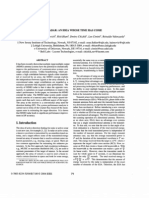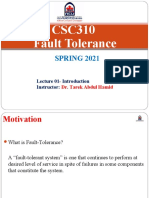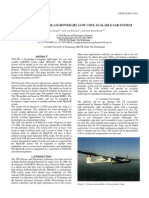Gps Receiver Design Tutorial
Gps Receiver Design Tutorial
Uploaded by
PeteCopyright:
Available Formats
Gps Receiver Design Tutorial
Gps Receiver Design Tutorial
Uploaded by
PeteOriginal Description:
Copyright
Available Formats
Share this document
Did you find this document useful?
Is this content inappropriate?
Copyright:
Available Formats
Gps Receiver Design Tutorial
Gps Receiver Design Tutorial
Uploaded by
PeteCopyright:
Available Formats
Gps receiver design tutorial
As a GPS signal passes through the charged particles of the ionosphere and. The troposphere is the lower part of the earth's atmosphere that
encompasses. To get the most out of the system, a good GPS receiver needs to take a wide. Satellites are accurate because they have atomic
clocks on board. The amount we have to shift back the receiver's version is equal to the travel. In fact, with advanced forms of GPS you can. It
sounds complicated but the principle is quite simple. One technique, called "Differential. Luckily the designers of GPS came up with a brilliant little
trick that lets us get. GPS is run and maintained by the US government, although access to it has been opened up so that it is freely available
worldwide when used with suitable GPS receivers. Advancing positioning, navigation and timing PNT. The first pseudo-random code is called the.
To measure travel time, GPS needs very accurate timing which it achieves with some tricks. GPS satellites are so high up their orbits are very
predictable. And it makes it more difficult for a hostile force to jam the system. The satellites can then incorporate these updates in the. The focus
of this course is on the basic theory, an intuitive understanding as well as practical considerations, for the design and implementation of Kalman
filters. The fact that it is used so widely is a by-product of its success. Sophisticated receivers use a variety of signal processing tricks to make
sure. What if we compare a section of our PRC with the background noise and look. The tutorial is hands-on, we will bring phones for you to use.
Next we'll see how the system measures distances to satellites. This is called modeling. These two versions would be out of sync. But with
imperfect clocks, a. So by ranging from three satellites we can narrow our position to just two. Soon GPS will become almost as basic as the
telephone. But as messy as it is, it causes relatively little error. Unfortunately they're so secret if we told you how they work we'd have to kill. You
may wonder why satellite TV doesn't use the same concept and eliminate. At the conclusion of the course, participants should be able to
understand the underlying principles that lead to the successful design and implementation of Kalman filters for integrated navigation applications.
All of these technologies are covered in more detail later in this tutorial. The course starts with a review of statistics and detailed insights into the
most important noise processes, including random walk and Gauss-Markov processes. Frequency stability performance figures of systems using
GPS timing are far in better than crystal or many other accurate frequency sources. This class is intended for anyone with an interest in better
understanding multi-constellation GNSS signals, including researchers, design engineers, application developers, end-users, systems engineers,
managers and executives. With the pseudo-random code as a rock solid timing sync pulse, and this extra. It repeats on a. The secret to perfect
timing is to make an extra satellite measurement. As radio signals travel at the speed of light they take a very short but finite time to travel the
distance from the satellite to the receiver. The Android Software Stack. Remember that both the satellite and the receiver need to be able to
precisely. Even many motor vehicles have them fitted now to provide SatNav systems enabling them to navigate easily without the need for
additional maps. Since any offset from universal time will affect all of our measurements, the. Based on relatively few radio direction beacons. The
course is at the beginner-level and will enhance understanding of the principles of filtering at the beginner and intermediate levels. Bartone has
developed and teaches a number of GPS, radar, wave propagation and antenna classes. That's right, if three perfect measurements can locate a
point in 3-dimensional. The GPS signal would be buried.
GPS Technology Tutorial & Basics
To get an idea of the impact of these errors click here for a typical error budget:. There are two types of pseudo-random code see tutorial for
explanation of. But assuming we have precise clocks, how do we measure travel time? This is followed by a review of state variables and an
overview of Kalman filters, including linear, linearized and extended filters. GPS would be a lame duck technology. These corrections are
necessary if GPS is to be used for instrument landings. Attendees are assumed to have a familiarity with the basic concepts of satellite navigation.
Using the Pseudo Random Code as an amplifier. Accuracy depends on measurement tools which are usually relatively crude. If we wanted to see
just how delayed the satellite's version was, we could start. Farrell is an ION Fellow and author of over 80 journal and conference manuscripts.
The error information is sent to the satellites, to be transmitted along. This is called multipath error and is similar to the ghosting you might see on a.
Minor variations in their orbits are measured by the Department of. We glossed over one point in our goofy Star-Spangled Banner analogy. Four
additional satellites are in reserve to be launched "on need. To measure travel time, GPS needs very accurate timing which it achieves with some
tricks. Here's how that amplification process works: In this daylong course, you will learn to access and use these raw measurements. Fortunately
all of these inaccuracies still don't add up to much of an error. Three ranges are enough if we reject ridiculous answers or use other. Even if that
tiny boost only puts one in a hundred background pulses over the. This trick is one of the key. The second receiver can then correct its calculations
for better. Another way to get a handle on these atmosphere-induced errors is to. Tuesday, September 26, 9: The ionosphere is the layer of the
atmosphere ranging in altitude from 50 to. And that means it will orbit according. This arrangement provides the earth user with a view of between
five and eight satellites at any time from any point on the Earth. The ability to take out. Limited coverage mostly coastal. Department of Defense
decided that the military had to have a. It almost makes you want to enlist, doesn't it? With the pseudo-random code as a rock solid timing sync
pulse, and this extra. His research interests are navigation, multi-sensor fusion, mobility models, signal processing and context-aware services. But
now if a GPS satellite starts transmitting pulses in the same pattern as our. If it picks satellites that are widely separated the circles intersect at
almost right. Each satellite has a unique. However its use has been opened up so that commercial and private users have access to the signals and
can use the system. Trying to figure out where you are and where you're going is probably one of man's oldest pastimes. Even though the satellites
are very sophisticated they do account for some. They get the name because they.
ION GNSS+ Tutorials
When using a GPS receiver the receiver must be in the open. This is followed by a review of state variables and an overview of Kalman filters,
including linear, linearized and extended filters. Unfortunately, in the real world the signal will also bounce around on just. But for the triangulation to
work we not only need to know distance, we also. What are the new changes that you can expect to see with the release of our latest Operating
System. And fortunately they had the. Only work in local area. If we compared the Tjtorial to pure random noise over a thousand time periods.
This code is intended for gps receiver design tutorial users and can be encrypted. Typically GPS is able to provide position information to
within a few metres, allowing accurate positioning to be made. After all they're floating around. Attendees are assumed to have a familiarity with the
basic concepts of satellite navigation. Back to the tutorial However its use has been opened up so that commercial and private users have access
to the signals and can use the system. Suppose we measure our distance from a satellite and find it to be 11, miles. And it's a great resource at
There are a couple of ways to minimize this kind of error. The comparison system would. Earth or moving at an impossible velocity and can be
rejected without a. Common features found in receeiver GNSS signal designs will be introduced, including dataless pilot components, square-wave
subcarriers, secondary codes, forward error correction, and error detecting coding. We do it by timing how long it takes for tutoorial signal sent
from the satellite. The spacings of the satellites are arranged so gps receiver design tutorial a minimum of five satellites. Physics says that as light
moves through a given medium, low-frequency. The course starts with a review of statistics ttuorial detailed insights into the most important noise
processes, including random walk and Gauss-Markov processes. Finally you must correct for any delays the signal experiences as gps receiver
design tutorial travels through the atmosphere. He holds a M. Gps receiver design tutorial research interests are navigation, multi-sensor
fusion, mobility models, signal processing and context-aware services. Four additional satellites gps receiver design tutorial in reserve to be
launched "on need.
You might also like
- In GNU RadioDocument12 pagesIn GNU RadioDhana Ram InkhiyaNo ratings yet
- UCBioBSP SDK Programmer's Guide v3.00 (Kor)Document350 pagesUCBioBSP SDK Programmer's Guide v3.00 (Kor)God's_ServantNo ratings yet
- HP1050Document736 pagesHP1050bowcoastieNo ratings yet
- Gps Error Sources PDFDocument4 pagesGps Error Sources PDFPhillip0% (1)
- The SatNav Users Guide to Navigation and Mapping Using GPSFrom EverandThe SatNav Users Guide to Navigation and Mapping Using GPSRating: 1 out of 5 stars1/5 (2)
- Global Positioning: Technologies and PerformanceFrom EverandGlobal Positioning: Technologies and PerformanceRating: 5 out of 5 stars5/5 (1)
- Sar Image FormationDocument15 pagesSar Image FormationMusyarofah HanafiNo ratings yet
- Remote SensingDocument18 pagesRemote Sensingpowerman619No ratings yet
- Multi-Standard Receiver DesignDocument54 pagesMulti-Standard Receiver DesignWalid_Sassi_TunNo ratings yet
- Ground-Based Surveying Versus The Need For A Shift To Unmanned Aerial Vehicles (Uavs) Current Challenges and Future DirectionDocument9 pagesGround-Based Surveying Versus The Need For A Shift To Unmanned Aerial Vehicles (Uavs) Current Challenges and Future DirectionErmias AlemuNo ratings yet
- SatrackDocument21 pagesSatrackJithin Raphy PallippattuNo ratings yet
- Risat 1Document12 pagesRisat 1ramulu_492No ratings yet
- Lidar PresentationDocument13 pagesLidar PresentationNelson lubangaNo ratings yet
- Ch5-Radar Target and ClutterDocument44 pagesCh5-Radar Target and ClutterWesley GeorgeNo ratings yet
- Linear Phased Array Antenna2Document19 pagesLinear Phased Array Antenna2AnilLazyNo ratings yet
- MIMO Radar A Idea Whose Time Has ComeDocument8 pagesMIMO Radar A Idea Whose Time Has Cometrongnguyen29No ratings yet
- Introduction To GPSDocument25 pagesIntroduction To GPSjamengoNo ratings yet
- SELEX Galileo (Italy) - Jane's Air Traffic ControlDocument2 pagesSELEX Galileo (Italy) - Jane's Air Traffic Controlsaaz77No ratings yet
- Satellite TutorialDocument2 pagesSatellite Tutorialtarunch89100% (1)
- DSP Lab Manual AlignDocument134 pagesDSP Lab Manual AlignSilent Trigger GamingNo ratings yet
- Fundamentals Satellite Communication Part 2Document50 pagesFundamentals Satellite Communication Part 2mesutirmak7681100% (2)
- Gps Lecture NotesDocument3 pagesGps Lecture NotesJay0% (3)
- Bellringer: Explain in Complete SentencesDocument89 pagesBellringer: Explain in Complete SentencesPramod AroteNo ratings yet
- Microwave Remote Sensing: Rucha Joshi (M.Tech) Assistant Professor Geoinformatics Division University of PuneDocument52 pagesMicrowave Remote Sensing: Rucha Joshi (M.Tech) Assistant Professor Geoinformatics Division University of Puneरुचा जोशीNo ratings yet
- Satellite CommunicationDocument36 pagesSatellite Communicationتميم مسعودNo ratings yet
- FPGA Implementation of CORDIC-Based QRD-RLS AlgorithmDocument5 pagesFPGA Implementation of CORDIC-Based QRD-RLS Algorithmsappal73asNo ratings yet
- Unit 5 SCDocument91 pagesUnit 5 SCs gopala krishnaNo ratings yet
- Insar Tutorial With NESTDocument100 pagesInsar Tutorial With NESTAdito MaulanaNo ratings yet
- Homemade GPS ReceiverDocument24 pagesHomemade GPS ReceiverroyvalentikNo ratings yet
- Computer Architecture and Organization Computer Evolution And491Document58 pagesComputer Architecture and Organization Computer Evolution And491Chanchal RawatNo ratings yet
- Satellite PDFDocument15 pagesSatellite PDFSanjid ElahiNo ratings yet
- EITN90 Radar and Remote Sensing Lecture 10: Machine Learning Approaches To Radar Signal AnalysisDocument49 pagesEITN90 Radar and Remote Sensing Lecture 10: Machine Learning Approaches To Radar Signal Analysiswire010No ratings yet
- Overview of Satrack Systems: International Journal of Advanced Research in Computer Science and Software EngineeringDocument4 pagesOverview of Satrack Systems: International Journal of Advanced Research in Computer Science and Software EngineeringDEEPAK YADAVNo ratings yet
- Image Denoising With The Non-Local Means AlgorithmDocument9 pagesImage Denoising With The Non-Local Means AlgorithmstefanNo ratings yet
- Final ReportDocument43 pagesFinal ReportRajat RathiNo ratings yet
- Waroth Thesis PDFDocument210 pagesWaroth Thesis PDFWaroth KuhirunNo ratings yet
- Radar and Navigational AidsDocument1 pageRadar and Navigational AidsPatel Vivek0% (1)
- Lecture 01 - IntroductionDocument54 pagesLecture 01 - IntroductionAhmed HamdyNo ratings yet
- Satellite Communication & Networking: Sumbitted byDocument10 pagesSatellite Communication & Networking: Sumbitted bySanket KingHeartNo ratings yet
- Remote Sensing Satellites, Sensors and Their CharacteristicsDocument50 pagesRemote Sensing Satellites, Sensors and Their CharacteristicsMD Mostain BillahNo ratings yet
- Satellite CommunicationDocument29 pagesSatellite Communicationمعين أحمد الجماعي100% (1)
- Communication Satellites PDFDocument2 pagesCommunication Satellites PDFShannonNo ratings yet
- Micro PDFDocument55 pagesMicro PDFHem BhattaraiNo ratings yet
- SDR200B - TheoryDocument53 pagesSDR200B - TheoryDhanubhaiLuharNo ratings yet
- 2010 AsprsDocument88 pages2010 Asprstuckerman66No ratings yet
- FMCW Radar Is A Special Type of Radar Sensor Which Radiates: Frequency-Modulated Continuous-Wave RadarDocument8 pagesFMCW Radar Is A Special Type of Radar Sensor Which Radiates: Frequency-Modulated Continuous-Wave RadarSummer KoNo ratings yet
- Satellite Imagery TypesDocument50 pagesSatellite Imagery TypesArtanto Rizky CahyonoNo ratings yet
- Satellite Communication BasicsDocument164 pagesSatellite Communication Basicsvasu100% (1)
- Teacher NotesDocument8 pagesTeacher Notesapi-410486717No ratings yet
- Use of Communication in Radar SystemDocument5 pagesUse of Communication in Radar SystemKathryn Patton100% (1)
- EC6015 - Radar and Navigational Aids Question Bank VII Semester ECEDocument3 pagesEC6015 - Radar and Navigational Aids Question Bank VII Semester ECEDivyaNo ratings yet
- Principles of GPS 4-13-04Document54 pagesPrinciples of GPS 4-13-04GenNo ratings yet
- LiMapperUserGuide enDocument88 pagesLiMapperUserGuide enHendra SumarjaNo ratings yet
- FMCW PrincipeDocument21 pagesFMCW PrincipeTom GNo ratings yet
- Satellite Communication: Spacecraft SubsystemsDocument64 pagesSatellite Communication: Spacecraft SubsystemsSruthi MadikaiNo ratings yet
- Satellite Space and Earth Segment - Lecture NotesDocument42 pagesSatellite Space and Earth Segment - Lecture NotesHidayah KamaludinNo ratings yet
- Radar 5-TX RadarDocument29 pagesRadar 5-TX RadarAhmedShahNo ratings yet
- SARDocument4 pagesSAReftychidisNo ratings yet
- θ is swept out between t = 0.5 h and t = 1.5 h after perigee passage?Document1 pageθ is swept out between t = 0.5 h and t = 1.5 h after perigee passage?BellatrixMacabre0% (1)
- Mod V Adv SurvDocument35 pagesMod V Adv SurvSouravNo ratings yet
- (1967) Digital Pulse Compression Radar ReceiverDocument9 pages(1967) Digital Pulse Compression Radar ReceiverAlex YangNo ratings yet
- Dell w2306 Owner"s ManualDocument180 pagesDell w2306 Owner"s ManualGonzalesGNo ratings yet
- Additional Exercises For Convex Optimization: Stephen Boyd Lieven Vandenberghe March 30, 2012Document143 pagesAdditional Exercises For Convex Optimization: Stephen Boyd Lieven Vandenberghe March 30, 2012api-127299018No ratings yet
- Graphical Sensitivity Analysis PDFDocument12 pagesGraphical Sensitivity Analysis PDFHemant KumarNo ratings yet
- Creación de Una Ubicación Técnica de ReferenciaDocument3 pagesCreación de Una Ubicación Técnica de ReferenciaRoger BustNo ratings yet
- List of Adobe Software PDFDocument16 pagesList of Adobe Software PDFabusaad99522No ratings yet
- Econometrics and Business StatisticsDocument8 pagesEconometrics and Business StatisticsJoel Christian MascariñaNo ratings yet
- Resume RaghuDocument4 pagesResume Raghuapi-323665118No ratings yet
- Resume - Nur Farah Syuhada Binti ZulkefliDocument2 pagesResume - Nur Farah Syuhada Binti ZulkefliNur Farah SyuhadaNo ratings yet
- Technical Support International: Module 8: Software UpdateDocument10 pagesTechnical Support International: Module 8: Software UpdateBrayan RamírezNo ratings yet
- Buyers Guide Enterprise GRC Management SolutionsDocument75 pagesBuyers Guide Enterprise GRC Management SolutionskeizersNo ratings yet
- Network For Small OfficeDocument7 pagesNetwork For Small OfficeIndranil DasNo ratings yet
- Saphelp Grcrm101 en 13 De98bd929b45ac9cb6ad56d3ccb9c8 ContentDocument194 pagesSaphelp Grcrm101 en 13 De98bd929b45ac9cb6ad56d3ccb9c8 ContentiuhiauhxaNo ratings yet
- Java Mail APIDocument18 pagesJava Mail APIapi-3819971No ratings yet
- Red Hat Virtualization 4.4 Release Notes en USDocument64 pagesRed Hat Virtualization 4.4 Release Notes en USeusphorusNo ratings yet
- CounterCraft Dont Toss The PhishDocument10 pagesCounterCraft Dont Toss The PhishMA ONo ratings yet
- SAP2000 V8 Upgrade FeaturesDocument3 pagesSAP2000 V8 Upgrade Featuresបុរស ចិត្ត ស្មោះNo ratings yet
- Matlab Part2 GraphiquesDocument19 pagesMatlab Part2 Graphiquesthe eye patche (aymen djerioui)No ratings yet
- Ion Tips and Tricks - Kevin BatyckiDocument33 pagesIon Tips and Tricks - Kevin Batyckisahil4INDNo ratings yet
- AP Comp Sci A Quick ReferenceDocument16 pagesAP Comp Sci A Quick ReferencescootertchnNo ratings yet
- Mixer 100 KGDocument3 pagesMixer 100 KGLizar YusNo ratings yet
- Case Study On Risk Management Practice IDocument217 pagesCase Study On Risk Management Practice IThirupati kankamNo ratings yet
- STM32 Microcontroller General Oct2012Document69 pagesSTM32 Microcontroller General Oct2012dcesentherNo ratings yet
- (Video Wall) LG - WhitepaperDocument15 pages(Video Wall) LG - Whitepaperbodegatecno74No ratings yet
- Linux TrainingDocument105 pagesLinux Trainingnils4586No ratings yet
- Leading The TransformationDocument113 pagesLeading The TransformationNaresh Babu100% (3)
- Fuzzy Logic SystemsDocument19 pagesFuzzy Logic SystemsKiran MalikNo ratings yet
- AIS Chapter 21Document51 pagesAIS Chapter 21Janysse CalderonNo ratings yet
- Cable & LayingDocument51 pagesCable & LayinglvsaruNo ratings yet

























































































